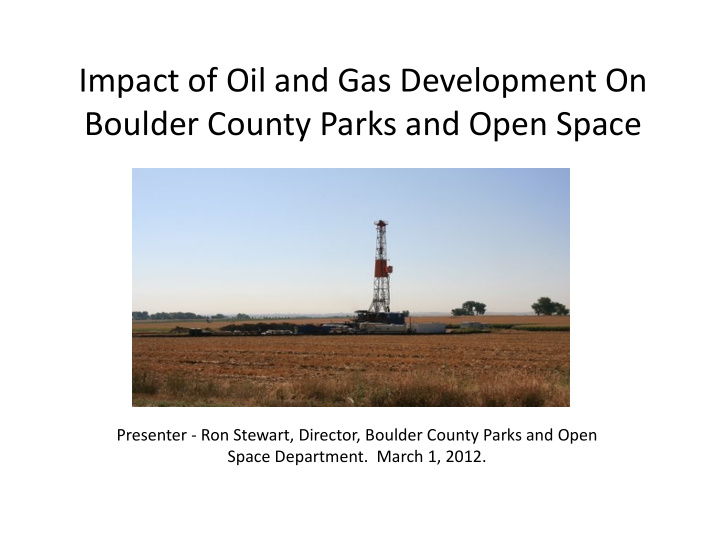



Impact of Oil and Gas Development On Boulder County Parks and Open Space Presenter - Ron Stewart, Director, Boulder County Parks and Open Space Department. March 1, 2012.
Why are there wells on Open Space? Oil and gas development is incompatible with the purposes of • open space. Not permitted under the Boulder County Comprehensive Plan • Not permitted under open space sales tax resolutions • Boulder County purchased agricultural lands in eastern part of • the county that were already subject to oil and gas leases. Most oil and gas leases were entered into the 1970’s and early 1980’s, • and Open Space purchases began in early 1990’s. Boulder County has not, and will not, enter into additional oil and • gas leases on open space, but cannot stop oil and gas development under existing leases. Existing leases remain current as long as there is ongoing production • within the leased area or areas pooled with that lease
How many wells are there in Boulder County? a. Here is subpoint 1 b. Here is suppoint 2
How much oil and gas is produced in Boulder County?
• Oil and gas wells in Boulder County have produced between 200,000 and 250,000 barrels of oil and between 3,000,000 and 3,500,000 million cubic feet of natural gas over the past few years. • These numbers represent about 1% of the oil production and 1.5% of the gas production in Weld County. • Boulder County is at the far western edge of the Greater Wattenberg Area (7 th largest oil and gas field in the United States). It is unknown how much additional development there will be in Boulder County, but it could be substantial.
What control does the Parks and Open Space Department have with regard to oil and gas development on Open Space? • Staff requires oil and gas operators who wish to drill to assure they have the legal right to drill on Open Space. • Staff negotiates the most appropriate sites to be disturbed: – Least new roads – Least disturbance to agricultural production – Least impact to environmentally sensitive areas – Cluster development – To the extent possible, in previously disturbed areas • Staff negotiates Surface Use Agreements to establish siting of the well and related infrastructure, timing, access, and reclamation.
• Surface use agreements also establish that the operator is responsible for damage to Open Space outside the normal scope of operations. • Oil and gas lessees have extensive rights under Colorado law which limit what Boulder County can require of the oil and gas operators. • POS will refuse to agree to allow drilling when operators won’t agree to avoid critical resources. – Boulder County refused to enter into a surface use agreement and object to issuance of a COGCC permit when an operator sought to drill very closely to an active bald eagle nest. – After objecting with the COGCC, POS was able to negotiate a better location for the surface disturbance and the operator drilled directionally to reach the same bottom hole location.
What does Boulder County get in compensation for drilling on Open Space • Boulder County typically receives between $7,000 and $25,000 for each Surface Use Agreement. • In some instances where Boulder County owns some or all of the mineral rights, the County receives a 12%-18% royalty interest. • Boulder receives approximately $1,000,000 per year from these royalties. • Royalties are deposited in Boulder County’s general fund and used to support POS staff and operations.
Water tanks on 3-acre drilling pad East County Line Road – Regneir Conservation Easement in Weld County– February 17, 2012
What are the impacts to open space related to oil and gas operations? • Short term impacts: – large volume of truck traffic – noise, dust, and lights – drill rigs operates 24/7 for a minimum of one week. • Loss of agricultural production • Road damage • Disturbance of natural resources and wildlife • Noxious weeds • Negligence in some cases has led to: – Oil spills, disturbance to prairie dog fencing, destruction of irrigation and drain tile systems, and poor reclamation
Wellhead and Tank Battery February 17, 2012
Long Term Impacts to Open Space • Noxious weeds – Difficult to control weeds on denuded soil – Operators often do not follow up after drilling is complete • Soil Disturbance/Compaction – Soil structure is often destroyed – Historic drainage is altered – Crop yields can be diminished for decades • Increased roads/damage to existing roads • Impaired aesthetics – Wellheads, separators, tank batteries etc.
Maintenance activity - oil and gas road to a Tank Battery and Wellhead Henry Eastlack Open Space – February 17, 2012
Oxford Farm Open Space - December 2007
Has Parks and Open Space noticed a difference in the scale of impacts and volume of activity on Open Space? • New technologies allow for less impacts on undisturbed land and clustered development, however some technologies lead to larger footprints and longer durations of activity during drilling. • Not a large increase in drilling, however the COGCC has approved 16 new permits and POS has received 47 notices of intent to drill on Open Space in 2012. • There has been a dramatic increase of drilling occurring in Weld County. • It is reasonable to believe there will be increased drilling in Boulder County.
Recommend
More recommend